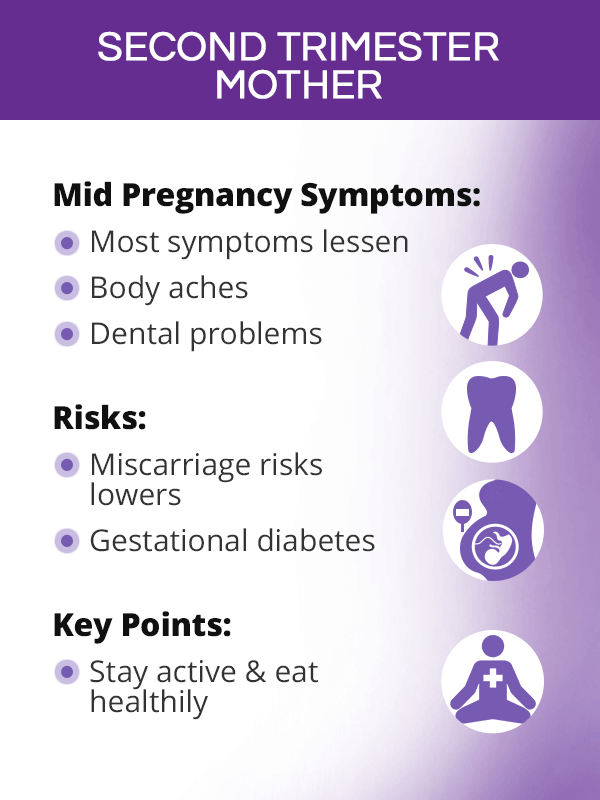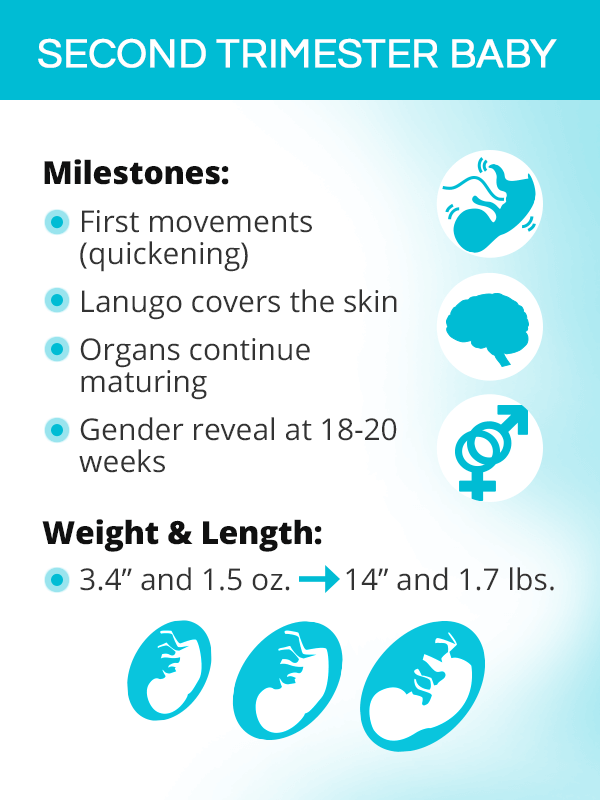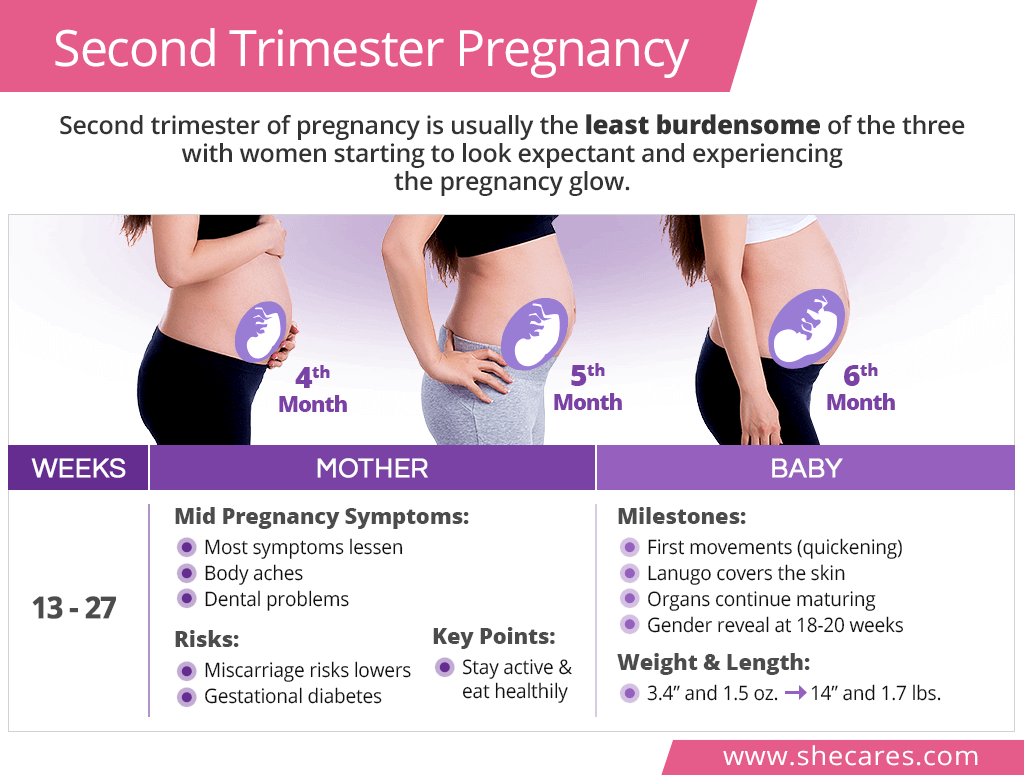Second Trimester Weeks

The second trimester weeks are counted from the beginning of the 13th week to the end of the 27th week of pregnancy.1
The second trimester falls right in the middle of the three stages of pregnancy, which cover a 40-week period from the first day of a woman's last period before conceiving until childbirth.
Although a pregnancy is considered “full term” when it lasts between 39 weeks 0 days to 40 weeks and 6 days, it is normal for women to give birth between 37 and 42 weeks.2
Second Trimester Mother

After first trimester battles with morning sickness, fatigue, and other early pregnancy symptoms, most women begin their second trimester feeling significant relief. Many of the discomforts lessen or disappear, and mothers-to-be often feel more energetic.
Although usually less bothersome, there are still various important second trimester changes in the mother. The growing belly starts to show more and more as the second trimester weeks pass by, and with a decreasing risk of miscarriage, women are more eager to share the good news with friends and family.
While some experience the pregnancy glow and feel and look their best, others struggle with the mask of pregnancy, called melasma, which consists of reddish patches on the face. Frequent complaints also include body aches, stretch marks, or itching on the abdomen. Dental problems are also more likely to appear in the second trimester.
Second Trimester Baby

As the baby enters the second trimester, he or she is about 3.4 inches long and weighs about 1.5 ounces. In the next three months, the baby will make a big jump and grow to 14 inches and 1.7 pounds.
Passing the 16th week of the second trimester, the baby's first movement may occur, referred to as quickening. Also, to protect the skin from amniotic fluid, the baby is covered in soft hair, lanugo, and a white coating, which will be shed before birth.
Besides an already functioning nervous system and kidneys, reproductive organs in the second trimester baby also mature. As such, an ultrasound typically done between the 18th and 20th weeks of pregnancy can reveal the baby's gender. Around the 23rd week, the chances of survival in the case of premature birth increase with every passing week.
Second Trimester Tests
In second trimester pregnancy, prenatal care will focus on monitoring baby's growth, ruling out genetic abnormalities, and recognizing signs of pregnancy complications, like gestational diabetes, which might develop between the 25th and 28th weeks.
Common prenatal tests women might be offered over the second trimester weeks include the following:
Pregnancy blood and urine tests: for signs of infections and sugar levels as well as maternal serum screen to determine the risk of having a baby with neural tube defects or genetic conditions
Pregnancy ultrasound: also called anomaly ultrasound; it is used to examine the baby for developmental abnormalities and reveal his or her gender (weeks 18-20)
Amniocentesis: a type of prenatal genetic testing to confirm or rule out genetic abnormalities (weeks 15-20)
Second Trimester Tips
Over the span of 15 weeks during the second trimester, it is a good idea to implement certain tips on how to stay healthy during pregnancy. Some of them might include the following recommendations:
Scheduling a dental check-up as periodontal disease can increase the risk of complications like preeclampsia
Focusing on a wholesome and well-balanced pregnancy diet with fresh fruits, vegetables, and good quality protein
Keeping up with regular, moderate level exercise during pregnancy, like walking, yoga, or swimming
Switching to comfortable, flat, and well-supported shoes to relieve swollen feet and back pain
Nurturing intimacy to stay in touch with each other's needs and boost blood flow to the pelvic area
Organizing a romantic getaway with one's partner, especially before the 36th week if it involves airplane travel
During the second trimester, the baby is growing quickly and needs the right nutrients. Pregnant women who have had a normal body mass index (BMI) before conceiving are recommended to increase their calorie intake by 300 calories per day.3 Underweight or overweight mothers-to-be are best to consult their doctors regarding their calorie intake during pregnancy.
Key Takeaways
For many women, the second trimester is the time to catch a breath right after an intensive hormonal roller-coaster of the first trimester and before the third trimester's excess weight and related discomforts. Although their bellies start to show, and various body aches begin to appear, they usually report feeling more energetic and empowered. As such, women are encouraged to focus their efforts into optimizing their diets, staying active, and taking time to rest. The baby, on the other hand, continues rapidly developing and steadily gaining weight. In the initial second trimester weeks, an ultrasound can already let the parents know if they are having a boy or a girl, while other prenatal tests can monitor the little one's development and ensure his or her well-being.
Sources
- Better Health Channel. (2012). Pregnancy - week by week. Retrieved June 12, 2019 from https://www.betterhealth.vic.gov.au/health/healthyliving/pregnancy-week-by-week
- Cleveland Clinic. (2014). Stages of Pregnancy & Fetal Development. Retrieved June 12, 2019 from https://my.clevelandclinic.org/health/articles/7247-fetal-development-stages-of-growth
- Embryology. (2019). Fetal Development. Retrieved June 12, 2019 from https://embryology.med.unsw.edu.au/embryology/index.php/Fetal_Development
- March of Dimes. (2018). What is Full Term? Retrieved June 12, 2019 from https://www.marchofdimes.org/pregnancy/what-is-full-term.aspx
- National Child & Maternal Health Education Program. (n.d). Full-Term Pregnancy. Retrieved June 12, 2019 from https://www1.nichd.nih.gov/ncmhep/initiatives/know-your-terms/Pages/moms.aspx
- Office on Women's Health. (2019). Stages of Pregnancy. Retrieved June 12, 2019 from https://www.womenshealth.gov/pregnancy/youre-pregnant-now-what/stages-pregnancy
- Planned Parenthood. (n.d.). Pregnancy: Month by Month. Retrieved June 12, 2019 from https://www.plannedparenthood.org/learn/pregnancy/pregnancy-month-by-month
- Sutter Health. (n.d.). Fetal development. Retrieved June 12, 2019 from http://www.babies.sutterhealth.org/babygrowth/fetaldev/index.html
Footnotes:
- KidsHealth. (n.d.). A Week-by-Week Pregnancy Calculator. Retrieved September 9, 2021 from https://kidshealth.org/en/parents/pregnancy-calendar-intro.html
- March of Dimes. (2018). What is full term? Retrieved September 8, 2021 from https://www.marchofdimes.org/pregnancy/what-is-full-term.aspx
- American Pregnancy Association. (n.d.). Pregnancy Nutrition. Retrieved September 9, 2021 from
https://americanpregnancy.org/healthy-pregnancy/pregnancy-health-wellness/pregnancy-nutrition/
